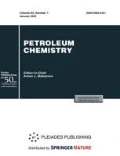Abstract
A number of unsupported NiMo, CoMo, and NiW sulfide catalysts synthesized in situ from oil-soluble precursors were investigated in hydrodechlorination of 1,4-dichlorobenzene. The unsupported NiW and NiMo sulfide catalysts exhibited the highest activity; after seven hours on stream in a batch-type reactor at 320°C and 4 MPa hydrogen, both catalysts achieved 99% conversion of 1,4-dichlorobenzene, and the selectivity towards chlorine-free products reached 99 and 78%, respectively. Under identical conditions, the CoMo(S) catalyst provided lower conversion (88%) with 100% selectivity. In contrast, under similar conditions a commercial NiW(S) catalyst exhibited comparable conversion with lower selectivity (95%), and a commercial NiMo(S) catalyst provided 82% conversion and 53% selectivity. The activity of the synthesized unsupported catalysts remained unchanged even after five cycles of reuse, whereas the commercial catalysts deactivated due to the destruction of the support when interacting with hydrogen chloride. The study revealed the optimum hydrodechlorination conditions in the presence of unsupported sulfide catalysts and identified the effects of the promoter to active metal ratio on conversion and selectivity. For the NiW(S) catalysts, it was found using X-ray photoelectron spectroscopy that tungsten was mostly present as WOxSy in the first cycle and WO3 in the fifth cycle, and nickel occurred in the NiS, Ni–W–S, and Ni2+ forms. Transmission electron microscopy showed the formation of fine-dispersed particles of NiS and WS2.








Similar content being viewed by others
REFERENCES
Zakharyan, E.M., Petrukhina, N.N., and Maksimov, A.L., Russ. J. Appl. Chem., 2020, vol. 93, pp. 1271–1313. https://doi.org/10.1134/S1070427220090013
Murena, F. and Gioia, F., Appl. Catal. B: Environm., 2002, vol. 38, pp. 39–50. https://doi.org/10.1016/S0926-3373(02)00025-5
Tohru, M., Tae, Y., and Yutaka, M., Catal. Today, 2004, vol. 88, pp. 111–120. https://doi.org/10.1016/j.cattod.2003.11.004
Gioia, F., Gallagher’, E.J., and Famiglietti, V., J. Hazard. Mat., 1994, vol. 38, no. 2, pp. 277–291. https://doi.org/10.1016/0304-3894(94)90028-0
Puello-Polo, E., Diaz, Y., and Brito, J.L., Catal. Commun., 2017, vol. 99, pp. 89–93. https://doi.org/10.1016/J.CATTOD.2009.05.025
Stanislaw, G. and Wojciech, P., Chemosphere, 2011, vol. 83, no. 3, pp. 334–339. https://doi.org/10.1016/j.chemosphere.2010.12.037
Bijan, F.H. and David, T.A., AIChE J., 1990, vol. 36, no. 5, pp. 773–778. https://doi.org/10.1002/aic.690360514
Martino, M., Rosal, R., Sastre, H., and Fernando, V., Appl. Catal. B. Environm., 1999, vol. 20, pp. 301–307. https://doi.org/10.1016/S0926-3373(98)00120-9
Gryglewicz, G., Stolarski, M., Gryglewicz, S., Klijanienko, A., Piechocki, W., Hoste, S., Van Driessche, I., Carleer, R., and Yperman, J., Chemosphere, 2005, vol. 62, no. 1, pp. 135–141. https://doi.org/10.1016/j.chemosphere.2005.03.097
Khadzhiev, S.N., Kadiev, H.M., Zekel, L.A., and Kadieva, M.H., Petrol. Chem., 2018, vol. 3, no. 1, pp. 535–541. https://doi.org/10.1134/S0965544118070046
Sizova, I.A., Antonov, S.V., Serdyukov, S.I., and Maksimov, A.L., Petrol. Chem., 2017, vol. 57, no. 1, pp. 66–70. https://doi.org/10.1134/S0965544117010121
Kasztelan, S., Toulhoat, H., Grimblot, J., and Bonnelle, J.P., Appl. Catal., A, 1984, vol. 13, pp. 127–159. https://doi.org/10.1016/S0166-9834(00)83333-3
Kniazeva, M.I., Kuchinskaya, T.S., and Erasheva, A.S., Petrol. Chem., 2021, vol. 61, no. 6, pp. 682–687. https://doi.org/10.1134/S0965544121040034
Wenbin, H., Yasong Zh., Qiang, W., Xiaodong, L., Pengfei, Z., Zhusong, Xu., Zhiqing, Yu., Xiaohan, W., Haoran, L., Xiaojun, D., and Han, Y, Fuel, 2022, vol. 319, article 123802. https://doi.org/10.1016/j.fuel.2022.123802
Lai, W., Chen, Z., Zhu, J., Yang, L., Zheng, J., Yi, X., and Fang, W., Nanoscale, 2016, vol. 8, no. 6, pp. 3823–3833. https://doi.org/10.1039/c5nr08841k
Funding
This work was carried out within the State Program of TIPS RAS.
Author information
Authors and Affiliations
Corresponding author
Ethics declarations
The authors declare no conflict of interest requiring disclosure in this article.
Rights and permissions
About this article
Cite this article
Dzhabarov, E.G., Petrukhina, N.N. Hydrodechlorination of 1,4-Dichlorobenzene over Unsupported Sulfide Catalysts. Pet. Chem. 62, 1334–1342 (2022). https://doi.org/10.1134/S0965544122110032
Received:
Revised:
Accepted:
Published:
Issue Date:
DOI: https://doi.org/10.1134/S0965544122110032




